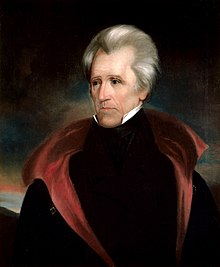
Back Andrew Jackson Afrikaans አንድሪው ጃክሰን Amharic Andrew Jackson AN Andreas Jackson ANG أندرو جاكسون Arabic أندرو دجاكسون ARY اندرو جاكسون ARZ Andrew Jackson AST एन्ड्रयु ज्याक्सन AWA Andrew Jackson Aymara
Andrew Jackson | |
|---|---|
 Portrait by Ralph E. W. Earl, 1833 | |
| 7th President of the United States | |
| In office March 4, 1829 – March 4, 1837 | |
| Vice President | John C. Calhoun (1829-1832) Martin Van Buren (1833-1837) |
| Preceded by | John Quincy Adams |
| Succeeded by | Martin Van Buren |
| Military Governor of Florida | |
| In office March 10, 1821 – December 31, 1821 | |
| Appointed by | James Monroe |
| Preceded by | Position established |
| Succeeded by | William Pope Duval |
| United States Senator from Tennessee | |
| In office March 4, 1823 – October 14, 1825 | |
| Preceded by | John Williams |
| Succeeded by | Hugh Lawson White |
| In office September 26, 1797 – April 1, 1798 | |
| Preceded by | William Cocke |
| Succeeded by | Daniel Smith |
| Member of the U.S. House of Representatives from Tennessee's at-large district | |
| In office December 4, 1796 – September 26, 1797 | |
| Preceded by | Position established |
| Succeeded by | William Claiborne |
| Personal details | |
| Born | March 15, 1767 Waxhaw settlements, Carolina, USA |
| Died | June 8, 1845 (aged 78) Nashville, Tennessee, USA |
| Nationality | American |
| Political party | Democratic |
| Spouse(s) | Rachel Donelson Robards Jackson (niece Emily Donelson Jackson and daughter-in-law Sarah Yorke Jackson were first ladies) |
| Children | Andrew Jackson III, Lyncoya Jackson, Theodore Jackson |
| Parents | Andrew Jackson, Sr. (father) Elizabeth Hutchinson Jackson (mother) |
| Religion | Presbyterianism |
Andrew Jackson Jr. (March 15, 1767 – June 8, 1845) was an American politician who was the seventh president of the United States from 1829 to 1837. He was the first president to be a Democrat[1] and is on the twenty dollar bill. His nickname was "Old Hickory". He forced many Native Americans to leave their homeland so white people could live there, and many died and contracted diseases. This was called the Trail of Tears. He was also the first president to ride in a train.
- ↑ President Andrew Jackson the First Democrat[permanent dead link] at College Term Papers.com